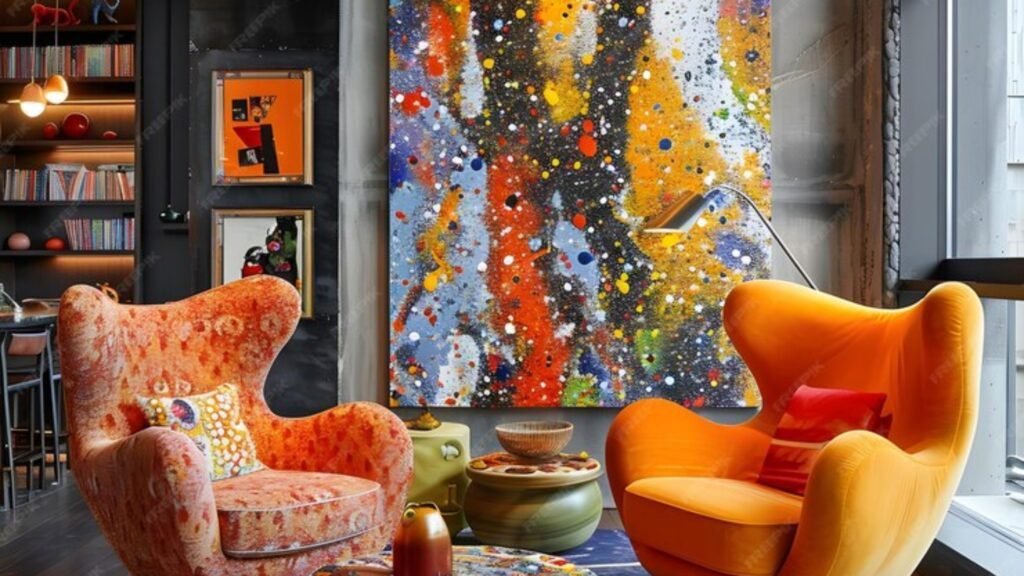When considering how to enhance the look and feel of a home, art furniture stands out as a captivating solution. Art furniture merges the worlds of creativity and practicality, offering pieces that are not just functional but are works of art themselves. From uniquely sculpted chairs to hand-painted tables, art furniture gives your living space an expressive edge that reflects personality and artistic flair. But what exactly is art furniture, and how can it be integrated into your home effectively?
Read also: How Does Furniture Consignment Work?
Table of Contents
ToggleWhat is Art Furniture?
Art furniture is more than just something to sit on or use for storage. It is a combination of utility and artistic expression. Each piece is thoughtfully crafted, often by designers and artisans, to not only serve a purpose but to enhance the aesthetic of any room it occupies. Unlike traditional furniture that prioritizes function alone, art furniture adds visual intrigue and craftsmanship into the equation. This means every item is designed with a balance of usability and artistic intention, transforming furniture into an artistic statement.
Types of Art Furniture


Art furniture comes in various forms, and each has its own unique appeal. Some popular types include:
- Sculptural Furniture: This involves pieces shaped in abstract or visually striking forms, often acting as a centerpiece in the room.
- Hand-Painted Pieces: These are custom-painted items, often featuring intricate designs or motifs that make each piece one-of-a-kind.
- Furniture Made from Unconventional Materials: Reclaimed wood, glass, metal, and even mixed media elements are often used to create distinctive art furniture. These materials give the pieces a unique texture and appeal, setting them apart from traditional furniture.
The Role of Artists and Designers
Art furniture is typically the result of a collaboration between artists, craftsmen, and designers. These creators push the boundaries of traditional furniture design, creating one-of-a-kind pieces that are both functional and visually arresting. Some notable names in the field have been known to blur the lines between art and furniture, crafting items that are seen in both galleries and homes alike.
Benefits of Incorporating Art Furniture into Your Home



Incorporating art furniture into your home brings a variety of benefits that go beyond simple function. Here’s why you should consider adding art furniture to your space:
1. Adds Personality and Character
One of the major advantages of art furniture is how it instantly adds personality to a room. Ordinary furniture may serve its purpose, but it often lacks the visual appeal and emotional connection that art furniture brings. Whether it’s a vibrant chair or an intricately designed table, art furniture reflects your personal style and taste, giving your home a distinct identity.
2. Enhances the Aesthetic Appeal
Art furniture serves as a conversation starter and a focal point in any room. It can tie together the design elements of a space, creating cohesion between your decor choices while still standing out as a unique piece. By incorporating an artistic element, your space can move beyond functional to become more of an artistic showcase.
3. Limited Editions and Customization
One of the most exciting aspects of art furniture is the availability of limited edition or custom pieces. Since many art furniture items are made in small batches or are entirely unique, owning one ensures that your home will have something exclusive. Customization also allows you to have furniture made to suit your specific needs and style, ensuring it fits seamlessly into your decor.
4. Sustainable and Ethical Choices
Many art furniture creators focus on using eco-friendly materials and ethical production practices. Pieces made from reclaimed or sustainable materials not only look amazing but also contribute to a more environmentally conscious lifestyle. Choosing these types of furniture can reduce your environmental impact while supporting artisans who use sustainable practices.
How to Choose the Right Art Furniture
Selecting the right art furniture for your home is about more than just picking the most beautiful piece. There are several factors to consider to ensure that your selection complements your space and lifestyle.
1. Understanding Your Space
Before purchasing art furniture, it’s important to analyze the space it will occupy. Consider the size of the room, the layout, and how you want the furniture to function. Will the piece be a focal point, or should it blend in with existing decor? Understanding the purpose and atmosphere of the room will help guide your choice.
2. Selecting the Right Artist or Designer
With so many designers and artists creating art furniture, it’s important to research those whose work aligns with your vision. Take the time to browse portfolios, visit galleries, or attend exhibitions to get a sense of the type of work that appeals to you. Some designers specialize in sculptural pieces, while others may focus on more functional designs, so narrowing down your preferences will make the selection process easier.
3. Material Considerations
Art furniture comes in various materials, and your choice of material can impact both the aesthetic and durability of the piece. Wooden furniture often brings warmth and classic appeal, while metal or glass can create a more modern or industrial look. Choose a material that not only suits your style but also complements the existing elements in your home.
4. Budgeting and Investment
While some art furniture can be an investment, it’s essential to set a budget before you start shopping. The cost of art furniture can vary depending on the artist, materials, and exclusivity of the piece. Consider whether you’re willing to invest in a one-of-a-kind item or if a more affordable, but still unique, piece might be a better fit for your budget. Remember, art furniture can appreciate in value, making it a potential investment for the future.
How to Incorporate Art Furniture into Different Spaces
Art furniture has the potential to transform different areas of your home, creating distinctive environments in each room. Here are some ideas for integrating art furniture into various spaces:
1. Living Room
The living room is often the heart of the home, making it an ideal space for art furniture. A statement chair, an eye-catching coffee table, or a sculptural light fixture can serve as the centerpiece of the room, drawing attention and adding sophistication. When blending art furniture with traditional pieces, aim to create balance by ensuring the artistic element stands out without overpowering the room.
2. Bedroom
Art furniture in the bedroom can create a calming, personal retreat. Think about incorporating artistic headboards, dressers, or bedside tables that bring a sense of creativity while still providing functionality. Since the bedroom is a personal space, it’s a great area to introduce custom or one-of-a-kind pieces that reflect your individual style.
3. Dining Room
The dining room is a perfect space for bold, artistic pieces. A uniquely designed dining table or a set of artful chairs can transform the room into a stylish area for entertaining guests. The dining room also provides an opportunity to play with textures and materials, blending wood, metal, or glass elements to create a cohesive yet intriguing space.
4. Office and Workspace
Art furniture can be functional and inspiring in a workspace. A creatively designed desk, artistic shelving, or a sculptural chair can help make the space more enjoyable and foster creativity. The right art furniture in your office can turn a simple room into a place where ideas flow freely and productivity soars.
5. Outdoor Spaces
Art furniture isn’t limited to indoor spaces. Outdoor areas, such as patios or gardens, can benefit from sculptural pieces that complement the natural environment. Consider art furniture made from weather-resistant materials like metal or treated wood to ensure durability while still making a stylish statement in your outdoor living area.
The Art Furniture Shopping Experience



When shopping for art furniture, knowing where to look and what to consider can help ensure you find the perfect piece for your home.
1. Where to Buy
Art furniture can be found in galleries, design showrooms, and online platforms dedicated to unique home decor. Visiting a showroom allows you to see the piece in person, assess its size and material, and get a feel for how it might fit in your space. Online platforms often offer a wider selection and can connect you with artists from around the world.
2. How to Customize
Customization is a big part of the art furniture experience. If you have a specific vision in mind, many artists and designers offer bespoke services that allow you to commission a piece that fits your exact requirements. Customizing art furniture can involve selecting materials, adjusting sizes, or incorporating unique design elements that make the piece truly yours.
3. Questions to Ask Before Purchasing
Before making a purchase, it’s important to ask a few key questions to ensure the piece will meet your needs. Consider durability and maintenance—how easy will it be to care for the piece? Also, inquire about shipping and installation, especially if the item is large or fragile. Some art furniture may require professional installation, so it’s worth considering these factors beforehand.
Art Furniture as an Investment
Owning art furniture is not only about having beautiful pieces in your home—it can also be a smart investment.
1. Value Over Time
Art furniture often appreciates in value, especially if the artist becomes well-known or if the piece is part of a limited edition. Collectors often seek out unique or rare items, so owning art furniture can increase in value over time, making it a wise investment for those who appreciate both design and functionality.
2. Emotional and Aesthetic Value
Beyond financial value, art furniture brings a deep sense of emotional and aesthetic satisfaction. Unlike mass-produced items, art furniture has character and individuality, bringing joy and a personal connection to the owner. This emotional attachment often outweighs its functional purpose, making it a prized part of any home.
3. Combining Art and Function
The beauty of art furniture lies in its ability to serve both artistic and functional roles. It’s not just a piece of art to be admired from afar—it’s something that is used daily, creating a deep
appreciation for its craftsmanship and design. This dual role makes art furniture an ideal investment, blending art with practical use.
The Future of Art Furniture
Art furniture continues to evolve, with designers pushing boundaries and exploring new trends.



1. Innovation and New Trends
Emerging trends in art furniture include the use of technology, such as 3D printing and sustainable materials, to create innovative designs. Modular furniture, which can be rearranged or transformed, is also becoming more popular, allowing homeowners to adapt their spaces to suit changing needs.
2. Blurring the Line Between Art and Functionality
The future of art furniture lies in further blurring the distinction between art and everyday items. More than ever, designers are creating pieces that serve multiple purposes, from furniture that functions as art to art that doubles as functional items. This trend is likely to continue, redefining how we think about furniture and interior design.
Conclusion
Art furniture offers a transformative way to elevate your home’s interior design. With its unique blend of functionality and artistic expression, it has the power to turn any room into a gallery-worthy space. Whether you’re looking for a statement piece or a subtle touch of artistry, art furniture can reflect your style, enhance your living space, and even serve as a valuable investment for years to come.
FAQs
What is art furniture?
Furniture With A Creative Touch. A new style that draws inspiration from the work of well-known artists is art-inspired furniture. Not only is this furniture functional, but it also gives your house some personality.
What is a furniture artist called?
A furniture maker is sometimes called a carpenter or furniture designer. More generally, you can refer to someone who makes furniture by hand as a craftsperson or artisan.
Can furniture be fine art?
Interior designer Anna Haines says “Absolutely, furniture can also be art. I think there has long been scope for furniture to blur the lines between its aesthetic and artistic value and its function.






